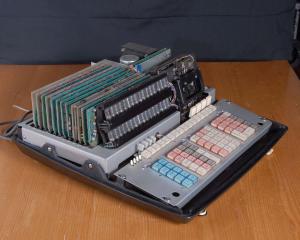Wang 700 Technology
Electronics
TTL small-scal integration ICs, 7400 and 9900 series
Architecture, Memory & Speed
- Microcoded architecture with hardware logic controlled by 40-bit microcode word.
- 10 displayed digits, 1 sign digit, 2 digit exponent
- Read-Write Core Matrix memory, 8k bits for 120 addressable registers plus internal store
- Read-only Core Rope style memory for microcode
The Wang 700 series was a major advance in Wang’s calculator technology, being the stage at which Wang moved from a hardwired to a microcoded architecture. The LOCI and 300 series machines were hardwired, with their electronic gates directly implementing the logic required for the calculator’s functions. To change the functions available on one of these machines one had to change the actual wiring. Upgrades and special models would require electronic design changes and new production line runs.
In a microcoded architecture the actual electronic logic provides a set of quite simple building-block functions. A read-only memory and a sequencing mechanism supply a series of “microcodes” which direct the basic logic to perform functions which build up to be the operations of the actual calculator. The calculator seen by the user is actually a microcode program, running on a general-purpose logic machine. Upgrades and special models can now be provided simply by changing the microcode loaded into the read-only memory. The basic electronics remain the same and could be used across multiple models, even as one model became obsolete and was replaced by another.
The microcode architecture was not designed for the 700 series, and indeed the 700 series was not originally part of Wang’s plans. The 700 series arose as a response to Hewlett Packard’s HP 9100 programmable calculator which was a serious threat to Wang’s business immediately upon its introduction. Wang had actually been developing the microcode architecture for a proposed small computer but the HP 9100 required an immediate response. Since the computer project was microcoded, it was possible to revise the microcode so that the machine became an advanced programmable calculator.
The 700 series was also Wang’s first use of integrated circuits, being built almost entirely from 7400 and 9900 series small scale integration TTL ICs.
Wang continued its traditional use of magnetic core memory in the 700 series. Read-write storage was conventional core matrix memory while the microcode ROM was “core-rope”, a simplified type of core memory that was read-only. Core rope is a labour-intensive technology but would have been very familiar to Wang, and at the time it was one of the few means of producing large read-only memories. The cost and labour elements of core rope were less important to users such as NASA, where core rope was used for the ROMs in the Apollo Guidance Computer. Hewlett Packard used a small core rope memory in their HP 9100 but the large microcode ROM was built with a printed circuit process that was invented by HP in-house. Wang stuck with the magnetic memory technology that was familiar to them but then had to find an economical means of mass-producing core ropes. Among other means, a machine was invented (and patented) that could automatically lay the miles of wire that each ROM required.
Construction
The 700 series are desktop machines, the cases are a major step up from the 300 series in their design but still manage to look utilitarian and low-tech. The keyboard is typical Wang with short-travel clicky microswitches marked with paper labels under generic clipon keytops. The appearance is in contrast to the HP9100 and carries on Wang’s uninspired approach to industrial design.
The main electronics are carried on 12 high-quality double sided PCBs. Two additional boards hold the nixie drivers. While the PCBs are high-quality construction, Wang persists in declining to gold plate the edge connector fingers.
The microcode ROM is built on a large PCB that is mounted in the base of the machine, well protected from damage although not entirely safe from a large coffee spill.
The power supply is a basic transformer design with series pass regulation for +5v and +/- 12v supplies.

